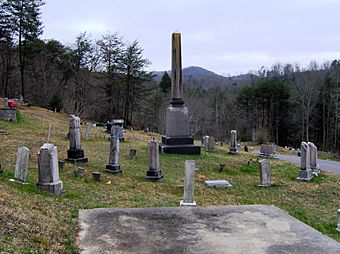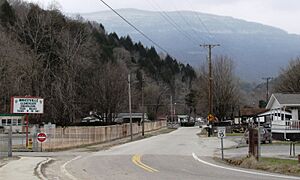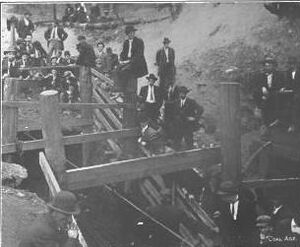Cross Mountain Mine disaster facts for kids
Quick facts for kids |
|
|
Cross Mountain Miners' Circle
|
|

Cross Mountain Miners' Circle
|
|
| Location | Circle Cemetery Lane |
|---|---|
| Nearest city | Briceville, Tennessee |
| Area | Less than 2 acres (0.81 ha) |
| Built | 1911 |
| NRHP reference No. | 06000134 |
| Added to NRHP | March 15, 2006 |
The Cross Mountain Mine disaster was a terrible coal mine explosion. It happened on December 9, 1911, near a town called Briceville, Tennessee. Even with a big rescue effort by the new Bureau of Mines, 84 miners lost their lives. The explosion probably started when gas and coal dust caught fire after a part of the mine roof fell.
At least 22 of the miners who died were buried in a special round memorial. This place is known as the Cross Mountain Miners' Circle. It is now listed as an important historical site on the National Register of Historic Places.
Contents
Where is Cross Mountain?
Cross Mountain is a very large hill in Tennessee. It's part of the Cumberland Plateau, which is an area known for coal. This mountain is the highest point in Tennessee west of the Blue Ridge Mountains. It sits on the border between Anderson County and Campbell County.
A stream called Coal Creek flows near the mountain. This creek created a narrow valley where the towns of Briceville and Fraterville are located. The Cross Mountain Mine was found at the end of a small valley called Slatestone Hollow. This was about one mile west of Briceville.
What Caused the Mine Explosion?
Mining started at Cross Mountain in 1888. Over many years, a lot of fine coal dust built up inside the mine tunnels. On the morning of December 9, 1911, part of the mine roof fell. This caused dangerous methane gas to escape into the air.
It's believed that a miner with an open flame light came near the fallen roof. This light likely ignited the gas and coal dust. The explosion either killed or trapped all 89 miners who were working that morning.
How Did the Rescue Efforts Unfold?
After the explosion, families and people from nearby towns quickly gathered at the mine. Miners and engineers immediately started a rescue operation. They brought a large fan from another mine to clear the bad air and push fresh air into the tunnels.
A special rescue team from the Bureau of Mines arrived around noon. This Bureau had only been created the year before. The team had gas masks and oxygen tanks. They were also the first mine rescue team to use canaries in cages. These birds helped them detect dangerous air quality changes. Water was also pumped into the mine to put out fires.
Around midnight, the first three bodies were brought out. Two more bodies were found the next day. On Monday, rescue workers found five miners who had survived. They had built a barricade and had drinking water. Two of them were burned, and two had tried to find a way out.
On December 19, the last two miners, Alonzo Wood and Eugene Ault, were found. They had also built a barricade but had sadly died. Before they passed away, they wrote "farewell" messages to their families on the barricade wall.
What Happened After the Disaster?
The Cross Mountain Mine disaster was one of the first big rescue missions for the new Bureau of Mines. Even though only 5 of the 89 trapped miners were saved, the Bureau learned a lot. This information helped them improve future mine rescue efforts. The rescue also helped the Bureau gain public trust and continued funding.
The 84 miners who died were buried in several cemeteries nearby. At least 22 of them were buried in the special circular memorial. This place became known as the Cross Mountain Miners' Circle. It is located in Briceville. Soon after the disaster, the United Mine Workers of America placed a marble monument in the center of the Circle. It lists the names of all 84 miners who died. This memorial was added to the National Register of Historic Places in 2006.
Other miners were buried at the Briceville Community Church cemetery. Eugene Ault, one of the last miners found, is buried there. His monument has the "farewell message" he wrote in the mine.



